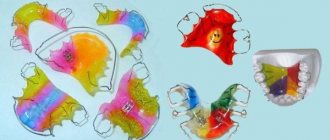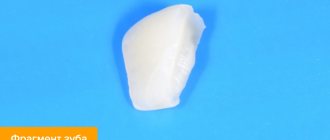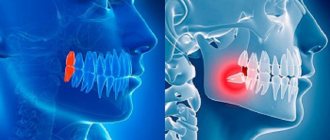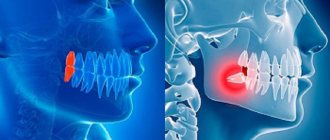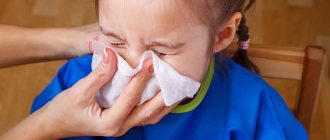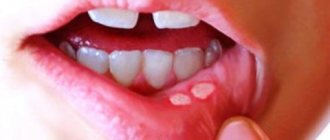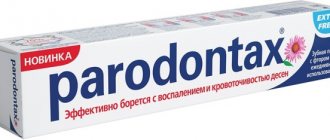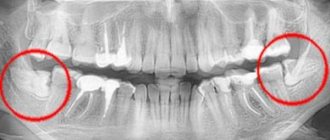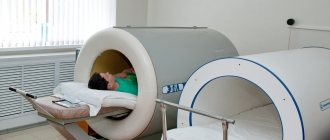The feeling of toothache, discomfort when chewing food, dislike of cold or hot drinks and even stiffness when breathing air prevents you from enjoying life. All these symptoms indicate the presence of a problem such as increased sensitivity of teeth. In our article we will try to give answers to the main questions regarding this topic: what is the cause of the disease and how to overcome it.
Why do teeth crumble in adults?
Causes of tooth decay
Habits that ruin your teeth
What to do to strengthen enamel
Prevention from destruction
Not everyone can boast of healthy and strong teeth. The reason is simple: most of us come to the dentist only when faced with serious problems. One of them is the destruction of enamel: teeth literally begin to crumble into small pieces. Why does this happen and how to strengthen weak enamel?
How to treat hypersensitivity at home
If pain or increased discomfort overtook you at home, or you simply cannot visit a doctor, then it is reasonable to think about folk remedies. In your home first aid kit, medicinal herbs and tinctures will help reduce tooth sensitivity:
- Burdock decoction. Pour water over the burdock particles, heat over low heat and then strain. We rinse our mouth several times a day. The product can relieve pain.
- Oak bark decoction. 200 milliliters of boiling water is poured into a tablespoon of bark, and then put on low heat. After 7 minutes, remove the broth and wait until it cools down. Strain and rinse your mouth with warm broth. Repeat the procedure several times throughout the day.
- Eggplant peel tincture. Peel the eggplant, dry the peel and grind it into powder. Pour 200 milliliters of boiling water and leave for half an hour. We rinse our mouth with the resulting tincture at least 4 times a day.
- Warmed boiled milk. It is better to heat homemade milk and drink it after holding it in your mouth for 10 seconds.
- Propolis. The soft, chewing-gum-like “bee” product strengthens tooth enamel. It can be chewed and attached to the tooth overnight.
In conclusion, it is worth adding that it is worth treating tooth sensitivity at home only when it is impossible to visit a doctor. Do not delay your visit to the clinic, as discomfort indicates problems. Therefore, examination and treatment should begin as early as possible.
sign up for a consultation
Causes of tooth decay
It happens that the enamel becomes fragile, cannot cope with the load and begins to crumble. Typically this process begins with the formation of small microcracks. Over time, they increase, leading to chips.
Tooth decay is influenced by many factors, both natural and mechanical.
- Poor hygiene. The accumulation of tartar and soft deposits create a favorable environment for the growth of bacteria. Those, in turn, release substances that destroy the enamel.
- Lack of vitamins and microelements that affect the formation of dental tissue, for example, vitamin D, calcium, phosphorus, etc.
- Abuse of sweets, alcohol, sour foods, seeds, smoking, sweet sodas. Simultaneous consumption of foods at different temperatures (ice cream and hot coffee).
- Bad habits: the habit of biting nails, a pen or pencil, opening a bottle with your teeth.
- Bruxism.
- Heredity.
- Diseases of the thyroid gland and endocrine system.
- Age-related changes.
- Pregnancy.
- Chronic diseases: arthritis, diabetes.
- Poor quality water.
Increased tooth wear - symptoms and treatment
Increased (pathological) tooth abrasion is an intense loss of hard tissues, which can lead to almost complete wear of the crown part of the teeth. It can be caused by congenital characteristics, somatic diseases, bad habits, abnormalities in the position of teeth, incorrect dental treatment and other factors. At the initial stage, the changes are almost unnoticeable, but as the disease progresses, the patient himself may notice a decrease in the length of the crowns of the teeth and a change in the shape of the chewing surfaces.
According to Alekseev, the author of scientific works and the book “Pathological abrasion of teeth,” increased abrasion of incisors, molars and premolars is detected in 4% of people aged 25–30 years. At the age of 30–40 years, almost 23% of patients seek orthopedic help due to increased tooth wear, at 40–45 years old - 35%, at 50–60 years old - 26%, after 60 years this figure decreases to 12% [2][ 13].
Physiological abrasion of the cusps of premolars and molars, the cutting surface of the front teeth in the process of chewing food is a natural process that is observed in every person. With age, the enamel wears off more intensively, and due to the natural mobility of teeth, facets are formed on the chewing surfaces, which are manifested by a decrease in the volume of hard tissues. The speed of this process depends on the strength of the enamel, bite and eating habits. Age-related changes in the temporomandibular joint and periodontal tissue can also cause tooth wear. Reducing the size of crowns serves as a compensatory reaction, allowing, under conditions of slowing metabolic processes, to maintain hard tissues in a normal state [1].
Causes of increased (pathological) tooth wear
The reasons can be general (pathological habits, work hazards, genetic abnormalities, chronic diseases) and local (bite pathology, tooth loss, bruxism, diet high in acids).
In some patients, pathological tooth wear is caused by harmful or professional habits: gnawing seeds or nuts, holding tools in the teeth, biting off threads. The characteristics of the enamel in these people correspond to the norm, but excess load leads to premature wear of the dental crowns. Even the strongest teeth need to be protected at a young age.
Other causes of pathological abrasion of enamel:
- malocclusion;
- bruxism (teeth grinding);
- loss of several teeth;
- wearing incorrectly made dentures, the shape of which does not correspond to the anatomical features of the patient’s oral cavity and does not ensure normal contact between the chewing surfaces;
- constant exposure of teeth to sand, soot and other solid particles;
- fluorosis (destruction of enamel associated with excess fluoride);
- amelogenesis imperfecta (hereditary disorder of the formation of tooth enamel);
- acid necrosis (destruction of enamel in patients who excessively consume acidic foods, as well as those in contact with acids in hazardous industries, as a rule, can be combined with enamel erosion);
- thyroid diseases;
- pathology of the pituitary gland;
- improper brushing of teeth [3].
Various malocclusions lead to a certain pattern of tooth wear:
- with a straight bite, the chewing surface of the molars and the cutting part of the incisors are intensively worn away;
- with a deep bite, the tissue of the front teeth decreases especially quickly, the lateral movements of the jaw in such people are limited, therefore the molars and premolars retain masticatory cusps even in adulthood;
- with an oblique bite or an anomaly in the position of part of the teeth, the process occurs asymmetrically with the abrasion of individual teeth.
When teeth are lost, the load during chewing is distributed unevenly and the remaining teeth take it upon themselves. This leads to their premature wear. If a person chews food on one side of the jaw due to dental disease, the wear of the crowns will be asymmetrical.
Another reason for premature enamel wear is improper installation of removable dentures . If the teeth, which are the supporting points for clasps (hooks for fixing the prosthesis), are not protected by artificial crowns, they will quickly wear out.
Increased tooth wear is observed in representatives of some professions:
- in persons engaged in physical labor, the pathology is associated with strong clenching of the jaws when lifting heavy objects;
- among foundry workers - with dust and gas contamination in the air;
- Chemical industry workers who come into contact with acids develop acid necrosis of the enamel.
Abnormal abrasion of enamel may be associated with diseases such as thyrotoxicosis , chronic cholecystitis, urolithiasis , and endemic fluorosis. They lead to the fact that the enamel loses its natural strength and quickly wears off even with minor mechanical stress. Diseases of the nervous system , one of the symptoms of which is bruxism, also have a negative impact
Pathological abrasion can be caused by hereditary anomalies, one of them is amelogenesis imperfecta . With this pathology, the quantity and mineralization of tooth enamel is disrupted and its density decreases. Accordingly, it will wear off faster than in people with healthy teeth [5].
With pathological tooth wear, it is first of all important to identify the cause; some patients need not only dental care, but also treatment of the underlying disease or lifestyle changes.
Habits that ruin your teeth every day
| Regular sweet snacks form plaque and destroy enamel |
| Biting foreign objects creates cracks |
| Bruxism: Teeth grinding at night causes tooth wear |
| Large amounts of citrus fruits: acid destroys enamel |
| Drinks with bright pigments stain tooth enamel |
| Improper brushing of teeth destroys enamel and injures gums |
| Frequent whitening with folk remedies destroys enamel and increases sensitivity |
Types of dental retention
There are many classifications of dental retention. One of the most popular methods of division is by degree of eruption. Thus, there are semi-impacted teeth , which are partially visible in the gum, and completely hidden - located under the gum or bone tissue. The latter are not available for palpation. If the impacted tooth is located in the gum tissue, the diagnosis will say “with tissue immersion,” but if it is located in the bone, “with bone immersion.”
Another classification method takes into account the position of the molar, canine or premolar:
- vertical,
- horizontal,
- corner.
Horizontal teeth can also be transverse, sagittal or oblique, and angular teeth can be mesial, distal, lingual or buccal angular. Rarely, but still there are reverse impacted teeth - these are elements that grow “upside down”, that is, their crown is directed towards the jaw.
What to do to strengthen enamel
Once the cause of the disease is determined, the doctor prescribes treatment. If the cause of tooth decay is untreated caries or mechanical damage, then the issue can be solved with the help of prosthetics. If the problem is a lack of vitamins or changes in hormonal levels, then specialized specialists will be involved in the treatment process.
What to do if you have tooth sensitivity
Remember that there is no one-size-fits-all treatment. The procedure depends directly on the case with which the patient consulted the doctor.
- If the discomfort is associated with the missing part of a tooth, the doctor independently restores it using composites.
- If irritability is caused by caries, then treatment is necessary. The doctor drills out the cavity and fills it, removing the affected areas of the tooth and adding medicine.
- If the cause of sensitivity is the complete destruction of tooth enamel, then the dentist performs remineralization - a procedure to coat the dentin with a special solution. As the solution hardens, it takes the shape of a tooth. The procedure does not cause pain, but takes some time. In addition, the patient will have to periodically visit the doctor to “refresh” the minerals.
- Laser treatment is also used - with the help of targeted beams, the ends of the dentin canals are sealed, preventing the flow of liquids into the tooth.
- Well, if all else fails, then depulpation is performed - removal of the dental nerve to remove painful sensations.
What will help strengthen the enamel?
- Professional oral hygiene. It will not only get rid of tartar and deposits, but also significantly reduce microbial activity in the mouth.
- Enamel remineralization or fluoridation. The enamel will receive additional nutrition, which will strengthen its structure.
- Taking multivitamins and calcium, a balanced diet.
- Hormonal therapy.
Pericoronitis of the wisdom tooth is a serious danger to health and even life
Between the erupting tooth and the gum a so-called “hood”, which promotes the accumulation of food debris and the growth of colonies of pathogenic bacteria. Ideal conditions are created for the development of pericoronitis - a purulent inflammatory process. In this case, the gums swell and swell, the body temperature rises, the patient experiences severe pain, and an unpleasant taste and smell appears in the mouth. The inflammatory process can spread to the periosteum, causing periostatitis, and even to the bone tissue of the jaw, causing a deadly disease - osteomyelitis.
Prevention from destruction
- A balanced diet rich in vitamins and microelements: meat, fish, vegetables, fruits, cereals. It is advisable that all these products be present in the daily diet.
- Monitor your vitamin D level, as calcium absorption depends on it.
- You should spend more time outdoors and, if necessary, take vitamin D supplements. To replenish calcium reserves, eat more legumes, dairy products, and almonds.
- Give up bad habits: do not chew pencils and pens, do not open bottles with your teeth.
- Regularly undergo preventive examinations at the dentist. At the first signs of enamel destruction, consult a doctor immediately.
As practice shows, in many cases a damaged crown can be saved. The main thing is not to delay your visit to the dental clinic. Be healthy!
Types of resorption
There are also two types of resorption, each of which, without treatment, can provoke complete tooth loss or partial tooth loss.
Internal resorption
Dentin (or cement shell) is absorbed into the root canal, dissolves, and disappears. Inflammation begins inside the tooth and then spreads to the outer surfaces. Usually the cause of the pathology is injury, burn (thermal, chemical), infection. Inflamed cells increase in size. The structure of soft and hard tissues changes. Symptoms of resorption:
- Changing the shade of the dental unit to pink. The tissue of the neurovascular bundle turns into granulomatous. After dying it turns gray.
- Painful sensations appear.
- The mobility of the units is noticeable.
Without diagnosis, the tooth becomes an empty shell. It is susceptible to caries, fragile - it splits at the slightest load. In the early stages, it is detected during preventive examinations or as a concomitant option in the treatment of other teeth.
External resorption
The reason is a consequence of injury, infection or a rapid change in the position of the roots (possible when installing braces). The enamel also changes color to medium red or pink. Develops at the junction with the tissues of the jaw. Causes:
- The action of pathogenic microflora inside the root canal.
- Dislocation of teeth.
- Necrosis of the nerve bundle.
There are no obvious symptoms. Blood capillaries of the gums and surrounding tissues penetrate into the tooth root, changing the shade of the crown. Changes can be detected by taking an x-ray. Rarely diagnosed in the early stages, loss of chewing teeth or loss of central teeth is possible. Doctors note an aggressive course, rapid development with extensive destructive processes, resorption of the dental bone tissue begins.
When is it necessary to remove an impacted tooth? Why remove impacted teeth?
Even an experienced surgeon will say that removing an impacted dystopic tooth is a serious and complex operation that should not be performed unnecessarily. Therefore, it is indicated in the following cases:
- inflammation of the soft tissues (pericoronitis) or jaw (osteomyelitis);
- the tooth is located in a follicular cyst or grows horizontally;
- a cyst or benign formation is diagnosed;
- pus or bacterial infection is detected.
Removal technique
Removal should be carried out by an experienced doctor who knows the specifics of working with impacted teeth. The main problem here is their inconvenient location, so it’s difficult for a beginner to cope with the problem. Removal takes place in several stages:
- Performing local anesthesia (in case of complex tooth position, general anesthesia can be used).
- An incision in the mucous membrane.
- Drilling into bone tissue to create a hole.
- Tooth extraction.
- Removal of tooth or bone fragments.
- Treatment of the wound.
- Stitching.
- Sutures are removed one week after surgery.
Often, the doctor has to first crush and then remove the tooth so as not to damage the adjacent molars and mucous membrane.
Contraindications
The operation will have to be postponed for the following reasons:
- the patient's serious condition due to any kind of illness;
- hypertensive crisis;
- nervous problems or mental disorders;
- viral infections;
- blood diseases;
- serious heart problems.
For women, this operation is not performed 2-3 days before the start of menstruation and after an abortion (at least 2 weeks must pass).
What complications occur after removal of impacted teeth? How to avoid them
Any operation can cause complications, and surgical treatment of an impacted tooth is no exception. Most often, the consequences manifest themselves as severe bleeding, pain, swelling of the gums or cheeks. If nerves are affected, increased sensitivity or insensitivity of the mouth and face may occur. Due to the incorrect actions of doctors, the patient faces a dislocation of the jaw or even a fracture.
The patient can avoid problems after surgery if he goes to a trusted clinic (excluding the human factor) and carefully takes care of the wound that appears in the mouth. Immediately after surgery, the patient should:
- refuse food for 3-4 hours;
- do not smoke for at least 3 hours;
- Avoid alcohol until the stitches are removed.
It is important to come back for a follow-up appointment with a surgeon or therapist. It is necessary to monitor the bleeding: if it does not stop for too long or painkillers do not work, you should contact the dentist immediately. Timely help will help avoid unpleasant consequences.
Postoperative care after removal of an impacted tooth
The doctor is obliged to advise the patient on how to properly care for the wound on the gum. Since removing an impacted tooth is a full-fledged operation, it is imperative to follow the rules of care. The patient needs:
- reduce physical activity to a minimum for 2-3 days after surgery;
- refuse hot and cold foods and liquids;
- change your toothbrush to a soft one;
- take only a warm shower or bath, do not visit baths and saunas;
- take all medications prescribed by your doctor (antibacterial therapy is usually prescribed).
It is important not to rinse your mouth so as not to disrupt the healing. You can make neat baths (liquid or herbal decoction is taken into the mouth, held without rinsing and spitting), but coordinate all procedures with your doctor.
How to stimulate tooth eruption
Stimulating the eruption of an impacted tooth is also one of the ways to treat the problem. The doctor prescribes specialized procedures if he sees that a molar or canine is positioned correctly, but its roots have not yet formed. Then the orthodontist recommends:
- Carrying out vacuum massage with special equipment;
- light finger massage at the site of eruption;
- electrical stimulation;
- exposure to ultrasound, laser, vibrating vacuum devices, etc.
Such methods are aimed at restoring blood circulation and accelerating metabolic processes in the gums.
Causes of impacted teeth. Is it possible to prevent retention?
The most popular reason for impacted teeth is genetic predisposition. Moreover, what is inherited is not the desire of the canines and molars to grow “some into the forest, some for firewood,” but the structure of the jaw. It can be narrow, which is why there is simply not enough space for all the necessary elements of the dentition. But there are other reasons:
- malocclusion, which has formed due to harmful myofunctional habits or mechanical injuries;
- early loss of baby teeth, due to which permanent teeth do not have guidelines for growth;
- “extra” teeth – atavism, called polyodontia;
- initially diseased tooth germs.
In some cases, retention problems can be prevented. Some orthodontists and pediatric dentists recommend the use of trainers to develop the dental arch and give growing canines and molars a guideline for eruption. If the problems are hereditary, only timely treatment will help.
You can read more about trainers in the article: Trainers for straightening teeth: description, varieties, tips for use
How to fix crumbling teeth
Once the cause is determined, treatment begins. If the condition of the teeth worsens due to diseases occurring in the body, the teeth are restored last - after other affected areas have been treated.
If the source of the problem lies in the oral cavity, the doctor may suggest several treatment options.
Caries or injuries lead to chips of varying sizes. They are removed with a filling.
- Crowns, veneers.
In case of serious damage to teeth, when filling does not help, it is recommended to install artificial crowns and veneers - porcelain or ceramic overlays.
A strengthening procedure during which applications containing calcium and fluoride are applied to damaged teeth.
- Fluoride coating of teeth.
The procedure also strengthens the enamel, but special fluoride-containing pastes are used.
- Taking multivitamins and nutritional supplements.
Installing veneers (onlays) is one of the ways to correct dental defects
Principles of treatment: is it possible to avoid surgery?
Many patients are sure that an impacted dystopic tooth is necessarily a reason for surgical intervention. But dentists try not to cut without a good reason. Therefore, if your extra teeth are not inflamed and do not interfere with your life, it is quite possible to avoid surgery. The doctor may also prescribe the installation of hard metal braces, which will “pull” the partially erupted tooth from the gum tissue and fit it into the dentition.
Typically treatment proceeds as follows:
- A diagnosis is carried out, which includes a visual examination and the creation of a panoramic image of the jaw.
- The doctor examines the results and decides whether the tooth needs to be removed. If yes, then surgery is prescribed.
- If the dentist sees other ways to solve the problem, he prefers them. First of all, the installation of a bracket system is considered. To do this, it is necessary that there is a place in the dentition where a new element could be placed.
- If braces are not required or cannot yet be placed, the doctor will try to help the tooth erupt. For this purpose, medications and surgery are used. Teething assistance is often used when the wisdom tooth is partially left under the gum, but is positioned correctly.
Modern doctors have many treatment methods in their arsenal, but everything completely depends on the specific case.
Stages of treatment for an impacted tooth
Why does tooth wear occur?
What determines the level of tooth wear?
Wearing of teeth throughout life is a natural process that occurs to one degree or another in every person. The level of abrasion of hard dental tissues depends on various factors - the general state of their health, genetic predisposition to various diseases, the quality of food and water quality, sufficient intake of essential minerals, and also work in certain hazardous industries, for example, in the chemical industry, can speed up the process erasing the enamel.
Conservative methods of treating retention
If the tooth is located correctly in the gum and there is minimal interference with eruption, doctors try not to remove it, but to return it to its intended place by nature. Different methods are used for this:
- laser correction;
- current pulses;
- gum massage;
- electrophoresis;
- some medicines.
All these treatment methods are aimed at making the tooth crown get rid of the gum hood on its own. They partially imitate the natural process of eruption of canines and molars. But the availability of such treatment depends on the situation.
What happens if bone tissue atrophy progresses?
The main difficulties faced by patients are:
- Facial aesthetics are changing. As we have already indicated above, the nasolabial folds become more pronounced, the face droops, the lips seem to sink, and deep creases form near the corners of the lips. Depending on the location of the atrophic process, the upper or lower jaw decreases in size.
It is important! Patients are often aged 20–30 years, but their face takes on the features of an “old man.” Why? Because they develop pronounced atrophic processes in bone tissue. It is very important, and even more so at a young age, to adjust this point in order to take care of the health and beauty of appearance.
